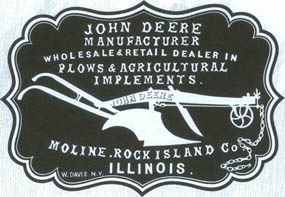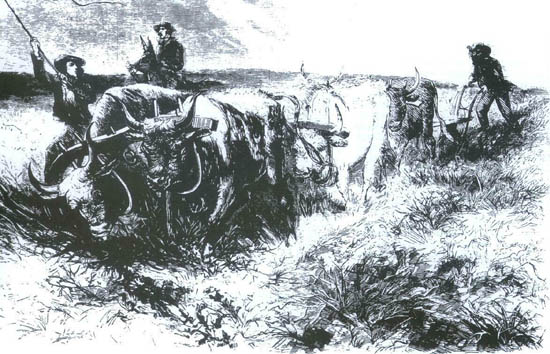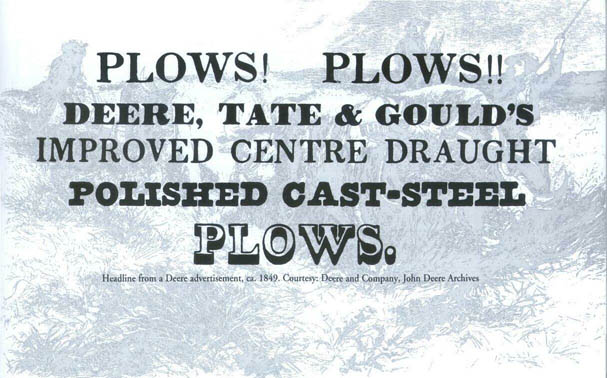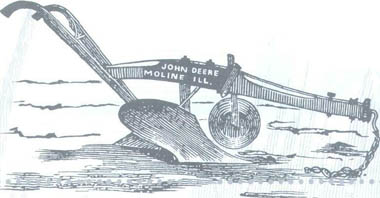|
C U R R I C U L U M M A T E R I A L S
|
Thomas Best
Overview
Main Ideas
Although just 1.3 percent of the American
public is still engaged in farming as an occupation, the sight of a brightly painted green and
yellow tractor with the "John Deere" label is
certainly a well-recognized product to both
rural and urban students. Nevertheless,
despite the continued overwhelming importance of agriculture to the Midwestern economy, few students are familiar with the history of
our agrarian past, the technological evolution of
farm equipment, and the impact that such
implements as John Deere's steel plow had
upon the development of the geography and
economy of America's prairies across the corn
and wheat belts. This lesson will help students
use the previous article to track the progress of
plow manufacturing and the unique contributions of the inventor, John Deere, to the agricultural history of Illinois, the United States,
and the world.
Connection to the Curriculum
This lesson can be taught as part of U.S.
history, Illinois history, or economics. The
activities may be appropriate for the Illinois
Learning Standards 15.B.2.a; 15.C.3; 15.C.4.b;
16.E.3.b.(US); 17.C.2.a; and 17.C.3.a.
Teaching Level
Grades 6-9
Materials for Each Student
• A copy of the narrative portion of this article
• Activity handouts
• Graph paper
• Drawing paper
Objectives for Each Student
• Create a descriptive and illustrated time line
that traces the technological improvements
associated with the history of the plow.
• Create a line or bar graph that traces the
manufacturing production of the plow by
John Deere and his company.
• Create an imaginary advertisement for a
John Deere plow from the nineteenth
century.
• Describe how a largely rural population
adapted, used, and changed the environment.
SUGGESTIONS FOR
TEACHING THE LESSON
|
Opening the Lesson
• Activity 1: Have the students read the narrative portion of this article with attention to the
technological improvements of the plow.
Students should take note of such factors as
what changes in materials and design have
improved the plow and the efficiency of farm
work.
• Activity 2: Using the narrative information
supplied in the historical article, students will
take a piece of graph paper and create a
descriptive and illustrated time line that
traces the technological improvements associated with the history of the plow from 4000
B.C. to 2000. This work could be completed
on an individual basis or in cooperative
groups to take advantage of different students' skills in reading and reporting information, analyzing written material, and art work.
This could also be completed as a whole
class form of instruction with students providing information and written and artistic contributions on a large sheet of paper, the bulletin
board, or chalkboard. Students will use
Handout 1.
• Activity 3: Using the narrative information
supplied in the historical article, students will
take the data supplied for the number of
plows manufactured by John Deere and his
company from 1837 to 1873. They will create either a line or bar graph that charts the
growth in production and describe or speculate on the cause and effects of production
advancement. Another dimension of this lesson could be to ask students to use their
7
"Plowing on the Prairies
Beyond the Mississippi,"
sketched by Theodore R.
Davis. Appeared in Harper's
Weekly, May 9, 1868.
Courtesy: Deere and
Company, John Deere
Archives
|
computation skills to determine how long it
took John Deere and his workers to complete
each plow. Students will use Handout 2.
• Activity 4: Students will create an imaginary
advertisement for a John Deere plow from
the nineteenth century. The students will
use information from the historical article
that illustrates the improvements made in the
plow by John Deere and its advantages over
other plows. They should create their advertisement employing characteristics of the
skills and creativity of John Deere. For
instance, consider how Deere's marketing
plans and advertising were attractive and
effective in selling his product to farmers.
Students will use Handout 3.

Logo from Deere & Company stationery, 1855.
Courtesy: Deere and Company, John Deere Archives
|
Developing the Lesson
Prior to the lesson, the teacher can gather
color pictures, brochures, advertisements, and
perhaps some collectible toy farm equipment
representing John Deere farm equipment from
a local farm-implement dealer. Those teachers without such business connections can
substitute such materials with a class trip to
Deere & Company through their web site at
www.deere.com, which offers information relating to Deere & Company's historic past under
John Deere to its modern industrial legacy as
one of the world's leading producers of agricultural, lawn, and forestry equipment. This
opportunity to see the modern state of technologically superior farm implements will assist
students in their understanding of the great
advancements in agricultural equipment since
early human agrarian activity There are links
on the web site to such topics as corporate
earnings, the geographic diversification of their
manufacturing centers, and a visit to the new
John Deere Pavilion and Commons in Moline.
Most importantly there is a historical section
dealing with the life of John Deere and the
John Deere Historic Site in Grand Detour.
Certainly, whether a teacher can obtain copies
of Deere materials or not, the Deere web site
will introduce students to pictures and an
overview of the history of this American inventor and entrepreneur.
Students should be encouraged to ask
their parents or other adults about the types of
8
farm equipment or lawn equipment that they
use. They can ask such questions as: "How
do their tractors or lawn mowers make their
jobs easier?" "Do they own John Deere
equipment?" "What influenced their decision
to buy this name brand?"
Concluding the Lesson
Students could be encouraged to speculate on what advancements might be made in
modern tractors and plows that will further
improve agricultural efficiency and production.
They could both draw and describe such
equipment for the twenty-first century. They
will want to describe what types of new materials or design features will be used in the tractor's engine, plow, wheels, etc. A visit again to
the John Deere web site at www.deere.com
will remind students of state-of-the-art farm
equipment featuring computerized planting systems and tractor cabs as comfortable as passenger vehicles.
Extending the Lesson
Samples of the student work in the forms
of the time lines, graphs, and advertisements
could be displayed in the teacher's room or
hallway. Representatives from the farming
community and farm-implement dealers could
be contacted to view the display and comment
on the accuracy and comprehension of plow
technology. This would be a great opportunity
to also invite members of the local media for
an illustration of how teachers and students are
applying their study of technology, history, and
economics, A contest with prizes (perhaps
replica farm equipment) could be held to
choose which advertisement would best attract
consumers of farm equipment.
To be fair to other dealers of agricultural
equipment, students could consult businesses
with competing brands of farm equipment to
learn of the history of their products and compare the evolution of their products with those
of John Deere's. Are there similar stories
about the founding of their companies? In
what ways was the evolution of their products
similar or different from John Deere? Students
might also look into the research of farm implement companies that no longer exist. What
factors that led to the success of Deere &
Company were missing from these businesses?
Students might adapt the type of problem
that faced John Deere to modern students or
workers. For instance, people often need a
better type of tool to make their work easier
and more profitable. Consider a type of work
that presently faces students or adults. Using
everyday materials and production techniques,
create a device that will serve people in their
work.
Teachers could arrange a field trip to the
John Deere Historic Site in Grand Detour (815-652-4551). There students will visit a museum
with a slide show of the history of John Deere,
9
examine the archeological remains of John
Deere's blacksmith shop, travel through a replica of the original blacksmith shop, and take a
tour of the Deere home in the same historic
block. The site is open daily from 9 A.M. to 5
P.M. from April 1 through October 31. There is
a $3 entrance fee for visitors 12 years and
older. Another museum worth visiting is the
new John Deere Commons (the Pavilion and
John Deere Store) in Moline (309-765-1000).
There students will view slide presentations
and displays tracing the history of farming in
the Midwest; engage in interactive displays
about various facets of farming, world population, and climate using computers and internet
connections; climb into the latest Deere tractors and combines; and tour the impressive
glass pavilion and store that features implements ranging from early Deere plows to the
John Deere NASCAR racing car in the John
Deere store next door.
Teachers of world history will also find
applications of this material in a global context.
Of course, material on the plow in world history
must be introduced. John Deere's work, however, is one of the important world examples.
Additional references to China would be helpful; consider: Joseph Needham, Science and
Civilization in China. 6 vols. Cambridge:
Cambridge University Press, 1956 -1984,
and Robert K. G. Temple, The Genius of
China: 3,000 Years of Science, Discovery,
and Invention (New York: Simon and Schuster,
1986).
Assessing the Lesson
• Activity 2: With the students creating a
descriptive and illustrated time line that
traces the technological improvements associated with the history of the plow from 4000
B.C. to 2000, teachers will look for evidence
of factual descriptions and graphic representations of the changes in the plow over this
span of time. What people, inventions, and
events were tied to the evolution of the plow
and its impact on improved farming techniques and food production?
• Activity 3: With the students taking the data
supplied for the number of plows manufactured by John Deere and his company from
1837 to 1873, their line or bar graph should
accurately reflect the increases in production
of plows along the two axes, charting the
years and number of plows manufactured.
Following the graph, students will then
describe and/or speculate on the causes
and/or effects of production advancement.
If students were asked to use their computation skills to determine how long it took John
Deere and his workers to complete each
plow, the teacher can check on the accuracy
of student work according the length of time
based upon how many plows might have
been produced in one hour, one day, one
week one month, etc.
• Activity 4: Students will create an imaginary
advertisement for a John Deere plow of the
mid-nineteenth century that features both
written and graphic characteristics of Deere's
plow. The advertisement should emphasize
the advantages of this plow over previous or
other plows and use written and visual techniques to be both accurate and eye-catching
as a form of marketing and advertising.
10

- Review the narrative portion of this article.
A. As the students read and take notes, they should record evidence of changes in
materials and the design of the plow and how these factors improved the efficiency
of farm work and agricultural production.
B. Whether as individuals, in cooperative groups, or with the class as a whole, record
the date, narrative description of the changes or improvement in the plow, and a
graphic or picture of what they think the plow will look like at this time in history.
This can be first done on pieces of graph paper to keep student work organized and
to make it easy to read and view. A large piece of paper could be extended across
a bulletin board to record student findings and their narrative and visual offerings.
Their findings should emphasize the people, innovations, and events tied to the evolution of the plow and its impact on improved farming techniques and food production.
- The following dates from the article should be most informative and relate more specifically
to the evolution of making, manufacturing and marketing the plow from 4,000 B.C. to 1997:
|
4,000 B.C.
|
1818
|
1848
|
1873
|
|
3,000 B.C.
|
1833
|
1849
|
1886
|
|
1,100 B.C.
|
1837
|
1857
|
1895
|
|
1600s
|
1839
|
1858
|
1911
|
|
1731
|
1840
|
1859
|
1913
|
|
1780s
|
1841
|
1863
|
1963
|
|
1793
|
1842
|
1864
|
1985
|
|
1797
|
1843
|
1867
|
1997
|
|
1803
|
1846
|
1868
|
|
11

- Review the narrative portion of this article.
A. After the students read and take notes, they will then list the year and data that
matches the number of plows that John Deere and his company produced from
1837 to 1873.
B. With the data recorded in note format, use the graph paper to construct either a line
or bar graph that charts the growth in production of plows made by John Deere and
his workers. The vertical axis should record the number of plows manufactured.
The horizontal axis should list the year of production.
- Whether as individuals, in cooperative groups, or in a class as a whole, describe and/or speculate on the causes and effects of production advancement. Students may consider such
factors as the availability of raw or manufactured materials, technological improvements,
changes in the U.S. or world economies, increased labor force, changes in marketing, etc.
- The article emphasizes the following years for study:
|
1837
|
1843
|
|
1839
|
1848
|
|
1840
|
1849
|
|
1841
|
1857
|
|
1842
|
1873
|
- Teachers and students can further their study of John Deere and his legacy by visiting and
using the following internet sites. A "must stop" would be at the John Deere Company web
site at www.deere.com, which includes a link to the John Deere Commons center in Moline,
Illinois. One can read a biography of Deere, view some of the paintings at this museum, and
link their computer to another page with information about the Deere Archeological Site at
Grand Detour. The Virtual Vermont web site has a brief biography and links to the birthplace
of John Deere at www.virtualvermont.com/jdeere. The Illinois connections to Deere and the
lives of early farmers in Illinois can be investigated at the Illinois Alive! site at
www.ras.lib.il.us/~ilalive/. The city of Moline has historical information on one of the most
influential nineteenth-century leaders of their city at www.moline.il.us/history/. For a look
at a scientific study of the prairie in Illinois, direct their search toward
www.inhs.uiuc.edu/~kenr/tallgrass3.html.
12

- Review the narrative portion of this article.
- Students will use the available information from the historical narrative and the additional detail
listed below to create an imaginary advertisement for a John Deere plow from the nineteenth
century. The advertisement should include written and/or graphic illustrations of the improvements made in the plow by John Deere and its advantages over other plows. In designing the
"copy," or written portion of the advertisement, they should also consider characteristics of the
skills and creativity of John Deere that made his marketing plans and advertising attractive and
effective in selling his product to farmers. The advertisement should be accurate and eye-catching.
- Some of the other features of the plow and John Deere's work that could be included in advertisement are: 1) the steel plow can clean or "scour" itself, with the sticky soil flowing off the plow
rather than sticking to the plow surface, thus saving time and physical labor; 2) its light weight
will make it possible for fewer and less powerful draft animals to pull the plow; 3) its system of
interchangeable parts will make for easy repair; 4) the plow will save money for the farmer in the
long run by not having to hire extra workers and plows to complete work when one is in a hurry;
5) John Deere's dedication to constant improvements, technological advancements, and top
notch service by Deere dealers; 6) John Deere's innovative marketing plans to offer plows on
credit, especially in tough economic times; and 7) the interesting descriptions and eye-catching
graphics to present the plow to the farmer in newspapers and farm journals. Additional information about the legacy of John Deere and his products are found on their web site with quotes
from John Deere such as: "I will never put my name on a plow that does not have in it the best
that is in me" (www.deere.com).

Click Here to return to the Article
13
|





